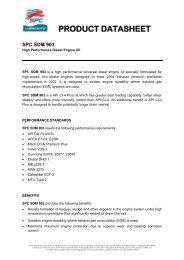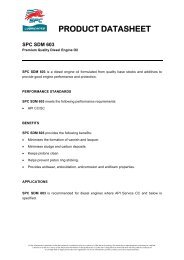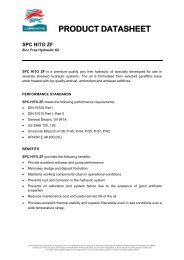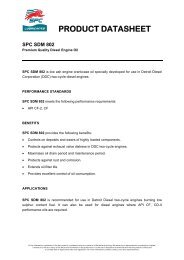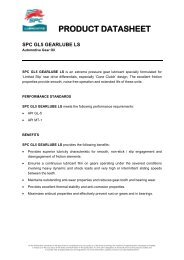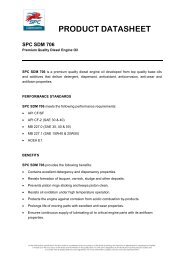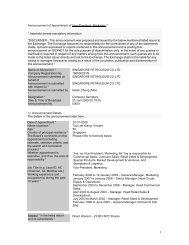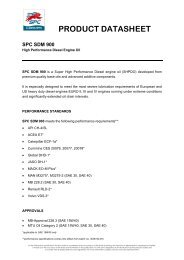UPSTREAM MIDSTREAM - SPC
UPSTREAM MIDSTREAM - SPC
UPSTREAM MIDSTREAM - SPC
Create successful ePaper yourself
Turn your PDF publications into a flip-book with our unique Google optimized e-Paper software.
Report to Shareholders 2003<br />
<strong>UPSTREAM</strong><br />
<strong>MIDSTREAM</strong><br />
Upstream<br />
<strong>SPC</strong>’s Upstream business, which centred on its 15 per cent<br />
working interest in the Kakap PSC (Production Sharing<br />
Contract) in offshore Indonesia, has continued to turn in a<br />
strong performance in 2003. Revenue for the year rose to<br />
$36.0 million, a record high for the Group since the asset was<br />
acquired in 2000. The strong revenue reported is a result of<br />
several positive factors which include higher realised oil and<br />
gas prices, sustained high oil production, as well as strong<br />
demand for Kakap gas from Singapore.<br />
As in 2002, the high oil price environment which characterised<br />
most of 2003 continued to pose challenges to <strong>SPC</strong> to achieve<br />
its planned growth in reserves through acquisition of producing<br />
assets. Few assets were put on the markets as upstream oil<br />
companies worldwide reported strong cash flow from their<br />
assets. In spite of this situation, <strong>SPC</strong> will actively seek out<br />
opportunities through its extensive presence and relationship in<br />
this region to grow its Upstream business.<br />
Oil and gas prices are expected to remain high in 2004. This is<br />
expected to benefit <strong>SPC</strong>’s Upstream activities with anticipated<br />
good realisation values.<br />
In addition to the strategy of acquiring producing assets, <strong>SPC</strong><br />
will consider participation in exploration ventures where the<br />
potential return is huge. With a modest risk capital, a successful<br />
exploration drilling could add significant value to <strong>SPC</strong>’s existing<br />
reserve base. The Group will take a measured approach to new<br />
exploration ventures to ensure a balanced overall risk profile for<br />
its businesses. <strong>SPC</strong> remains committed to the pursuit of its<br />
vision – “To be an integrated oil and gas company with a<br />
premium brand in Asia” and will continue to enhance its<br />
upstream portfolio through selective and targeted acquisition.<br />
Midstream<br />
On 4 August 2003, <strong>SPC</strong> and its partners officially<br />
commissioned Singapore’s second direct gas pipeline from<br />
Indonesia, the 468-kilometer Grissik-Batam-Singapore Pipeline.<br />
It was a milestone event attended by Singapore’s Prime Minister<br />
Goh Chok Tong and Indonesia President Megawati Sukarnoputri<br />
and the ASEAN energy ministers. The ceremony marked the<br />
start of a 20-year term gas sales contract reported to be worth<br />
some US$9 billion. Under the contract, initial gas delivery<br />
starts at 150 mmscf (million standard cubic feet) per day<br />
and is expected to rise to 350 mmscf per day by 2009.<br />
The construction of the Grissik-Batam-Singapore Pipeline<br />
project began in 2002 and was completed on time.<br />
Apart from the Grissik-Batam-Singapore Pipeline, <strong>SPC</strong> (as part<br />
of the joint venture company, Transasia Pipeline Company Pvt<br />
Ltd) owns and operates another gas transmission trunk line,<br />
the Grissik-Duri Pipeline, in Sumatra. Completed in 1998, the<br />
536-kilometre Grissik-Duri Pipeline transports gas to Caltex’s<br />
Duri facilities to power steam flooding for enhanced oil recovery<br />
under separate long-term contracts.<br />
Singapore’s first cross-border subsea gas pipeline from Indonesia,<br />
the West Natuna Transportation System (“WNTS”), began<br />
piping natural gas to Singapore in 2001 from the gas fields in<br />
the West Natuna Sea. Singapore has a 22-year contract with<br />
Pertamina for delivery of 2.5 tcf (trillion cubic feet) of natural<br />
gas via the 654-kilometre WNTS supplied by a consortium of<br />
three PSC blocks in West Natuna including Kakap.<br />
The commissioning of the Grissik-Batam-Singapore Pipeline<br />
has allowed Singapore to increase its import of natural gas to<br />
meet its growing demand for cleaner and more efficient fuel.<br />
Gas demand in Singapore, which has reached 600 mmscf<br />
per day, has been met with the timely commissioning of the<br />
28
Increasing Advantage<br />
second direct pipeline link and the present gas delivery<br />
through WNTS. Through its strategic ownership of key pieces<br />
of cross-border gas pipelines, <strong>SPC</strong> will continue to play an<br />
important role in ensuring the supply of energy resource to<br />
Singapore. With increased emphasis on securing oil and gas<br />
resources to meet long-term energy needs, the development<br />
of gas-line linkages among ASEAN nations is regarded as<br />
strategically important.<br />
The WNTS and Grissik-Batam-Singapore Pipeline are critical<br />
pieces developed today for future integration into the wider<br />
Trans-ASEAN Gas Pipeline (“TAGP”) network.<br />
The regional pipeline growth mapping is extensive and<br />
challenging, from the Myanmar-Thailand link to the Thailand-<br />
North Malaysia and Philippines transmission lines.These<br />
projects will be important to the regional economies, providing<br />
further integration and creating energy security and selfsufficiency.<br />
As a founding member representing Singapore in<br />
the ASEAN Council on Petroleum (“ASCOPE”), <strong>SPC</strong> identifies<br />
with the TAGP project and will continue to support and<br />
participate in future pipeline developments.<br />
One of the four Kakap platforms in Indonesia West Natuna Sea<br />
The Grissik-Batam-Singapore Pipeline was commissioned on 4 August 2003<br />
29




